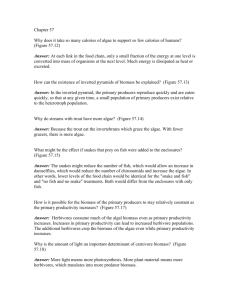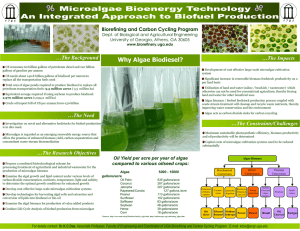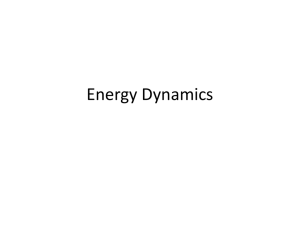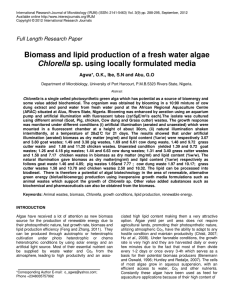Chapter6-Biomass Ene..
advertisement
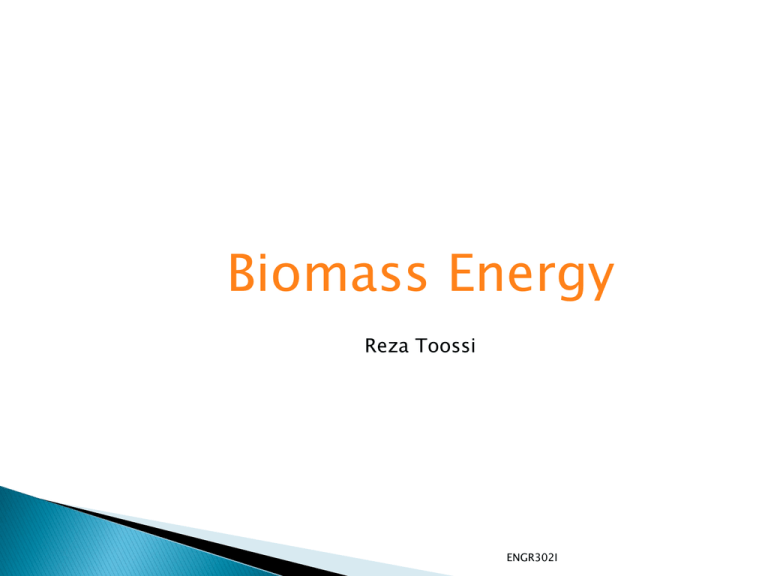
Biomass Energy Reza Toossi ENGR302I Energy from vegetable matter, produced through processes of photosynthesis Non fossil fuel organic matters ◦ ◦ ◦ ◦ ◦ Foodstuff, rice husks, peanut shells, and fruit pits Energy crops (willow, alfalfa, etc.) Papers, pulps, wooden products Municipal wastes Yard waste Tires and sewage sludge are sometimes included as biomass fuels. ENGR302I Photosynthesis is the process of removal of carbon dioxide from atmosphere by plants, in the presence of sunlight, and combining it with water to form carbohydrates. CO2 H 2O CH 2O O2 Sunlight The reverse process is called respiration, i.e. when biomass is burned in air to carbon dioxide and water. CH 2O O2 CO2 H 2O Energy ENGR302I Occurs in: ◦ Air (Chlorophyll absorbs red, another pigment absorbs the blue but reflects the green. The light absorbed is responsible for formation of adenosine triphosphate (ATP) which is a catalyst for formation of carbon dioxide to carbohydrate) ◦ Water (different set of pigments results in red algae) Common carbohydrates are: ◦ Glucose (C6H12O6) ◦ Sucrose (C12H22O11) ENGR302I Food production depends on the Amount of the land The productivity of the land Sunlight (112 kcal of light energy per mole of CH2O) Temperature Water (about a 1000 tons of water for each ton of biomass) ENGR302I Food Pyramid ◦ Autotrophs (self feeders) – plants, algae, bacteria ◦ Heterotrophs (other feeders) Primary consumers (herbivores) – vegetarians Secondary consumers (carnivores) – meat eaters Grass sheep wolf Plant insect frog man ENGR302I Energy needed for own growth (A) Energy needed to feed others (B) Gross (A+B) ENGR302I Chemical energy in food Mechanical energy in muscles ENGR302I M kg BMI 2 2 h m 19<BMI<25 Height, cm Healthy Mass, kg Height, feet Healthy Mass, lbs 150 43-56 5’ 0” 97-128 155 46-60 5’ 2” 104-136 160 49-64 5’ 4” 110-145 165 52-68 5’ 6” 117-155 170 55-72 5’ 8” 125-164 175 58-77 5’ 10” 132-174 180 62-81 6’ 0” 140-184 ENGR302I 1 Calorie = 1 kcal = 1,000 calories 1 Cal/h = kcal/h = 1.16 watts 1 MET = kcal/h/kg (of body mass) Example: A 110-lb woman is biking for 20 minutes @ 20 km/h (13 mph) ◦ Burn rate = 450 Cal/h = 522 W ◦ Total burned: 150 Cal = 626 kJ (muscle energy) ◦ MET = 450/50=9 ◦ With metabolic efficiency of 20%, we need 750 Cal of food energy ENGR302I Aerobic (Direct burning) ◦ Incinerators Anaerobic ◦ Thermochemical conversion (intense heat and pressure in absence of oxygen) Fisher-Tropsch (gasifying biomass in an oxygenstarved environment to produce syngas) ◦ Biochemical conversion (decay by microorganisms) ENGR302I US: Corn Ethanol (only 13% effective in reducing CO2) Brazil: Sugarcane Ethanol (90% efficient) Europe: Miscanthus Giganteus ◦ 1150 vs. 350 gallons of ethanol per acre of corn ◦ Need 100 million acres of miscanthus to meet all US demand for transportation. ENGR302I 85% of the cars sold in Brazil are “fuel-flex,” replacing 40% of their petroleum consumption. Officially became energy independent in 2006, i.e. its ethanol exports equal to its petroleum imports. But Half of the sugar crop goes to make fuel (food scarcity) Rainforests are cleared to plant soy Sugar: 8 times the energy put into it Corn: Only 1.3 times Cellulose (hard fibrous stuff making up stalks, husks, and cobs and tree trunks and branches): 36 Btu for every Btu put in ◦ Cellulose is best because it gives the most energy and at the same time is not suited for food ◦ The problem is crystalline structure (long chains of sixcarbon glucose molecules require expensive enzymes (proteins that catalyzes the chemical reaction) ◦ Termites make good enzymes (turn 95% of what they eat (wood) into energy (methane and hydrogen) Poplars and willows (Miscanthus grows up to thirteen feet with no need for fertilizers Jatropha (Very rich in inedible oil content, grows anywhere) Tall-grass prairie Algae (microscopic single-cell capable to survive in the harshest of environments) ◦ Acre of soybean 60 gallons of biofuel ◦ Acre of palm 600 gallons ◦ Acre of algae 6,000 gallons ENGR302I Modern landfills use plastic liners to prevent leachate and prevent it from draining deep into water supplies. ENGR302I Paper Other Glass Yard wastes Metals Paper Plastics RLT Food wastes Wood Wood Food wastes RLT Plastics Metals Yard wastes Glass Other ENGR302I ENGR302I Biomass energy is renewable, but not clean ◦ Sewage Sludge (household chemicals) ◦ Tires (when burned produce dioxins and PCBs, and toxic metals such as mercury, lead and arsenic) ◦ Wood Waste (Construction debris and paper pulp wastes may contain nails, metal staples and PVC contamination from electrical wires and other sources, glues, plastic laminates, phenol and formaldehyde resins) ENGR302I
